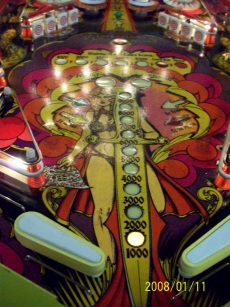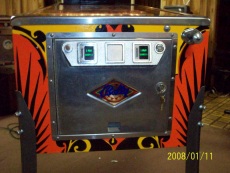SECTION 1: Electronics
Problem #1: Connectors on Rectifier board. I replaced the connector pins on the rectifier board and replaced the connectors.
Problem #2: I upgraded the power supply board. I upgraded the power supply board by doing some of the modifications suggested on Clay’s site. I replaced the 8 amp bridge rectifiers with the heftier 25 amp bridges. I also replaced the header pins and re-did the housing connectors.
Problem #3: Several lights did not work. On older games like this, determining the cause for non-working lights can be a pain because it can be a bad lamp, lamp socket, transistor, or connector. On this game, the biggest issue was that the pins and connectors needed to be replaced on the lamp driver board. After doing this, most of the lamps worked. The other non-working lamps were the result of bad sockets that had to be replaced.
Problem #4: Game would re-set after being on for awhile (after I sold it to my boss!) This was an issue that haunted me for over a year. When I started restoring this game, my original goal was to get it ready to sell for Christmas. After a while, I realized I wasn’t going to reach this goal, which was alright with me since I could keep it and play it (I really like Mata Hari). However, a week before Christmas, my boss asked if I had a game ready as he had always wanted to buy one for his wife. I showed him the Mata Hari and he wanted it. So, I frantically finished the restoration and everything seemed OK. However, at his house, after he played about 8 hours the game would reset. Then, this reset time continued to shorten over time until it got to the point that it would reset after being on for only 15 minutes.
This kind of problem isn’t easy to diagnose. Since the game powers up and plays normally for awhile, you can’t pinpoint what is actually causing the problem. I first thought it might be the capacitor on the driver board that regulates the voltage for the MPU. I took the board home and replaced the capacitor. This didn’t fix the problem. Next, I tried swapping out the driver board with a known good board. No luck here. Next, I swapped out the MPU with another working MPU. Alas, it still had problems. So, I’m worried that it may be the game PROMs. Also, I’m in a pickle in that I can’t really test the game when it messes up and I’ve tried installing new driver and MPU boards.
So, after about a year (he wasn’t in a real hurry to get it fixed and he realized I had rushed to get it done in the first place), we hauled the game back to my house so I could work on it there and have time to make it reset and try other things. Plus, a couple of lamps weren’t working and the saucer began to work only intermittently (during the time before the game would reset).
I decided to fix the easy problems first before tackling the reset issue. In fixing the lights and the saucer, I decided to re-do all of the connectors and pins on the power board. I had already done this, but I decided to go over my work just in case. I then replaced the lamp sockets for the lights in question and I re-did the connector on the driver board that carried the signal for the driver transistor to the saucer.
A funny thing happened, after making these fixes, the game worked perfectly and didn’t reset! So, I assume the issue had to be a power issue and that as the game warmed up a cracked solder joint or bad connector caused the power to the MPU to be interrupted for a moment, thus causing the game to reset. Whatever the issue was, re-doing my work on the power board fixed it.


